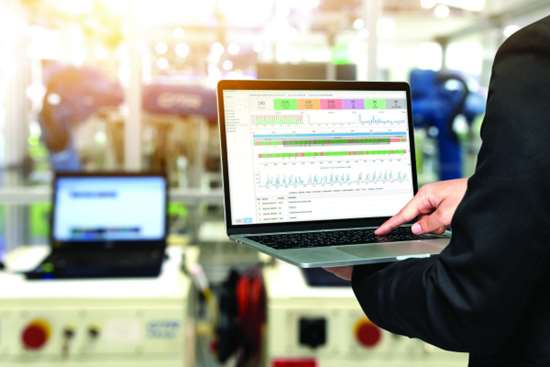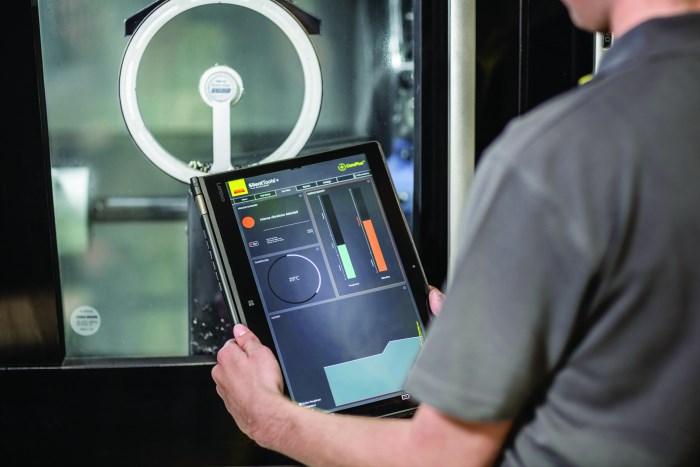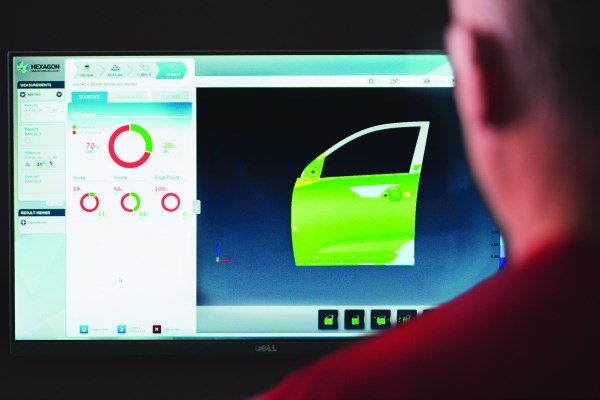The Network and the Sensor
The smart-factory world of digital manufacturing is coming, and manufacturing-technology developers are eager to help you be ready.
#iot
Market analysts International Data Corp. (idc.com) reported in December that worldwide spending on the Internet of Things (IoT)—intelligent equipment, processes and services that communicate with each other and with people over the internet—is expected to reach $772.5 billion in 2018, up 14.6 percent over the $674 billion spent in 2017. IoT hardware will be the largest technology category in 2018 with $239 billion going largely toward modules and sensors along with some spending on infrastructure and security. Services will be the second largest technology category, followed by software and connectivity.
Chasing the vision of the “smart factory,” the industry expected to spend the most on IoT solutions in 2018—with an expected spend of $189 billion—in manufacturing.
Terms such as smart factory, Industry 4.0 and Industrial Internet of Things (IIoT) have become inescapable buzzwords, invoked by every developer of manufacturing-related equipment and software. Many discussions of smart factories begin with prognosticators sharing visions of how the global manufacturing industry will be transformed. These descriptions often rope in burgeoning technologies such as additive manufacturing, 3D visual simulation and collaborative robotics. Are these requirements? Just what are the components of a smart factory? What makes a factory smart?
Two-way Communication
A useful way to understand the smart factory is to start with a comparatively simple technology at its heart: The inexpensive electronic sensor. In the pre-sensor world, to machine a part, the machine operator programs a CNC lathe or mill and the machine does its best to follow the instructions and removes metal. The communication is all one way, from the operator to the machine.
Did the machine accurately follow orders? Barring an obvious disaster such as a crash, the manufacturer won’t know unless he inspects the part after the operation is completed—which takes time and costs money.
Enter the sensor. Modern sensors strategically placed in the machining center can allow two-way communication: The sensors allow the machine to record or communicate information about its own status and the status of the operation while it works. Vibration measurement, temperature variation, motor current analysis and other factors can be shared over a network for monitoring and analysis. The status of the machine, and how that status affects the operation, can be assessed quickly—even in real time.
Where the sensor meets the machine tool is where the rubber meets the road in the IIoT. Sensor-enabled machines have a lot to say—more than a user may know what to do with. But analytics software can crunch the data and use it to improve the operation, maintain the machine, improve the product design—even improve the design of the machining equipment itself.
This same two-way communication approach has been scaled upward to make smart manufacturing cells, with automation and multiple machines—all enabled by sensors to share useful data.
Zoom out further and imagine an entire facility networked together this way, with the manufacturing data accessible and usable across formerly separate silos—comparable to the way enterprise resource planning (ERP) data has become.
That enticing vision of a manufacturing facility in which the equipment can share data with people and other equipment to allow faster, higher-quality, continuously improving production of parts and products—is the smart factory.
Technology Developers Want to Help
In spite of the media excitement about this brave new world of digital manufacturing, there are plenty of manufacturers who haven’t gotten started in preparing for it. If they decide they’re ready, they will find that their manufacturing-equipment vendors are ready and eager to help. In 2018, it seems that just about every provider of manufacturing equipment offers wares that they say are “Manufacturing 4.0-ready,” with sensors and software in place. Here are a few examples:
Machine-makers: At EMO 2017, Mazak Corp. (mazakusa.com) unveiled its iSmart Factory concept, which the company says enables machine users to make the leap from automated cell manufacturing to a completely connected Industry-4.0 factory. iSmart Factory uses the company’s SMOOTH Technology CNC and factory management software to connect machines and provides real-time monitoring and analysis capability. The system uses SmartBox, a cloud-based computing system that enables sensitive data to be analyzed and acted upon securely with optimal speed, with only selected data sent to the cloud for historical analysis and long-term storage. Using the MT Connect standard communication protocol, the system facilitates the real-time sharing of manufacturing data between the production floor and offices, allowing shorter lead times, reduced in-process inventory and lower indirect labor expenses.
Metrology specialists: Smart-factory technologies made one company change its name and mission: A couple of years ago Hexagon Metrology, Inc. became Hexagon Machining Intelligence (hexagonmi.com/en-us). Joel Martin, manager of the company’s laser tracker line, told me that the name change denotes a broadening “from just the science of measurement to looking at the entire manufacturing process.” In the past, their measurement equipment would collect data and “pass it off to someone who would have to decide what to do with it.” Now, statistical analysis software and CAD/CAM programs use the data to enable improvements to the manufacturing process. The 360º Flexible Measurement Cell, the company’s automated measurement work cell, enhances the manufacturing process by “seamlessly delivering actionable information,” Martin said. “The end-of-line measurements are still done for verification—but because we implement metrology so far upstream, and because of our quality processes, our statistical analyses and the analytics that drive the process, we already know that the part is going to be good.”
Cutting-tool makers: Cutting tool and tooling systems specialist Sandvik Coromant Co. (sandvik.coromant.com/en-us) offers a suite of IIoT solutions called “CoroPlus.” That’s the umbrella name of a platform of software and sensor-equipped tools made to improve productivity and control costs through a combination of connected machining and access to manufacturing data and expert knowledge. CoroPlus connects with existing software environments through open application programming interfaces (APIs), offering two-way connectivity and accurate data quality. The platform lets users optimize manufacturing through better insight into what’s happening on shop floors and in machining environments on either a micro or macro level. For a CAM programmer, connection with accurate tool and application data means that recommendations can be adapted to specific tasks. Operators benefit from the ability to remotely monitor machining processes. And specific sensor-equipped cutting tools can be controlled to ensure that breakages are avoided and performance details are secured, with data intelligence collected live throughout the machining process.
CAD-CAM Software Developers: This February, design and manufacturing software developer Autodesk, Inc. (autodesk.com) introduced its Fusion Production software. The program allows contract manufacturers to digitize their production by combining production planning, job tracking and machine monitoring into a single, complete tool. “Design, manufacturing and operations teams are very often spread out between states and even countries, making timely communication to key stakeholders more difficult,” explained senior director, business strategy Stephen Hooper in a company blog post. “Because Fusion Production provides real-time information from the shop floor to monitor work-in-progress across production, these teams are now able to immediately access production information at any given time, from any location.” Because of production and IIoT-enabled analytics, factory production managers are now able to use the program to harness data gathered through production processes and make it visible in real-time across the supply chain.
This has benefits at the product design level, he noted: Designers can view downstream processes to improve design for manufacturability.
Smart Startups
The above are all examples of existing manufacturing-technology developers providing smart factory-level solutions from their specific niches in the industry—tooling, machining center, software and so on. But new businesses are also springing up to enable or improve a manufacturer’s access to the two-way information exchange that’s at the heart of the concept.
MachineMetrics (machinemetrics.com), for example, is the name of a company and its product: a system designed to track everything that happens on CNC machines and make the most pertinent of the information visible and easily accessible by stakeholders from the operator on up. The MachineMetrics system acts as a historian for machine data—with the ability to export a machine's event history for any period of time. Information such as machine status, faults, programs, part cycles and job runs is displayed on the machine timeline. Users can view the status over time of all of their machines for a single day or drill down into a single machine for a detailed view. The Cycles Report, for example, provides statistical analysis on part cycles—which can uncover part cycle times that were potentially underestimated.
Getting Started
The frugal job-shop owner may well read the above description of their manufacturing-technology vendors eager to help them spend money on new IIoT-ready systems and instinctively hide his wallet. Does access to smart-factory benefits necessarily depend on investments in otherwise unneeded equipment such as new machining centers or tooling systems?
The answer, according to Tom Kelly, the executive director and CEO of technology consultancy Automation Alley Consortium (automationalley.com), is no. He advises small- to medium-sized manufacturers to not sit still, but also not to lay out a lot of money too quickly. “Don't try to eat the whole cow,” he said. “First, run some experiments, figure out what it is that’s valuable to you and your customers in very ‘digestible’ investments.”
Instead of investing in, say, a brand-new, IIoT sensor and software-equipped machining center, he suggests first “getting sensors installed onto your old machine that can kick data to your mobile phone on weekends and on the second shift. Learn what of this data is useful to you. If it is useless, then learn what kind of sensors will you need to get the useful data," he said. "We don’t want to suggest that the answer is necessarily ‘go buy the big machine.’ The person that does that could go bankrupt while waiting for Industry 4.0 to fully arrive.”
At an Automation Alley-hosted smart-manufacturing conference held in Detroit last November, a number of speakers agreed it makes sense to start small. Dennis Hodges, chief information officer at automotive supplier Inteva Products (intevaproducts.com), suggested starting with a question: “The first step is to ask yourself, what is it that keeps you up at night? Which machine or process keeps you up at night with worry or work? That’s the place to start.”
Michael King, president of the Data Analytics & IoT division of LHP Engineering Solutions (lhpes.com), suggested something like a genba walk approach to getting started: “One of the important things to do before anything else is to actually walk the shop and talk to your operators,” he says, “because they’re already monitoring the machines today.
"Ask your operators, ‘How do you know, before it actually goes, when that machine is starting to go? Or before you see the data?’ Some of the experienced operators will say ‘I can hear the spindle going a month before it fails.’ How do we capture that? You start by gathering that operator knowledge. And then you ask, how do I make that machine information visible? That would be step one.”
RELATED CONTENT
-
GM Develops a New Electrical Platform
GM engineers create a better electrical architecture that can handle the ever-increasing needs of vehicle systems
-
TRW Multi-Axis Acceleration Sensors Developed
Admittedly, this appears to be nothing more than a plastic molded part with an inserted bolt-shaped metal component.
-
Things to Know About Cam Grinding
By James Gaffney, Product Engineer, Precision Grinding and Patrick D. Redington, Manager, Precision Grinding Business Unit, Norton Company (Worcester, MA)












